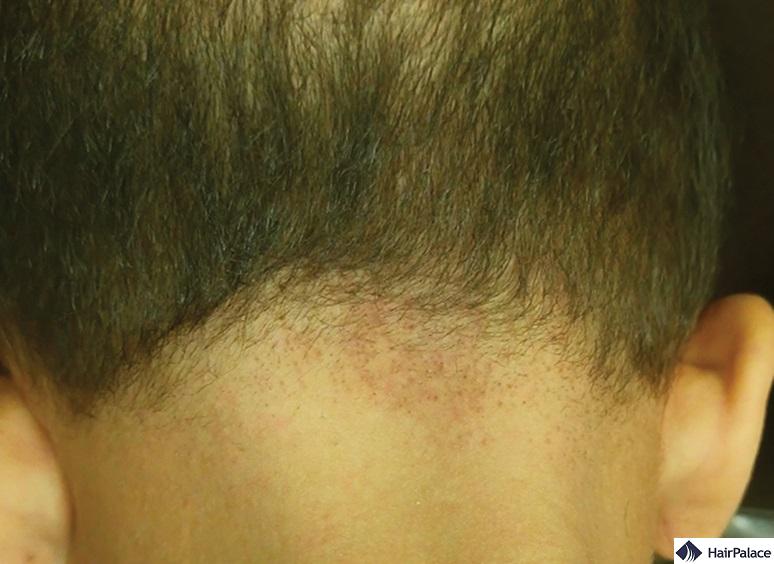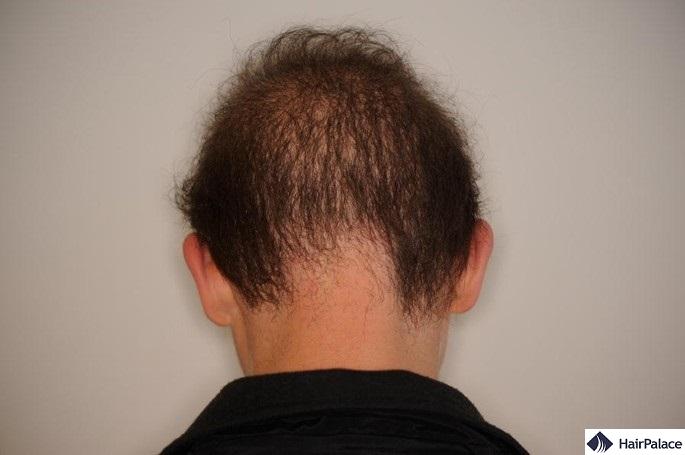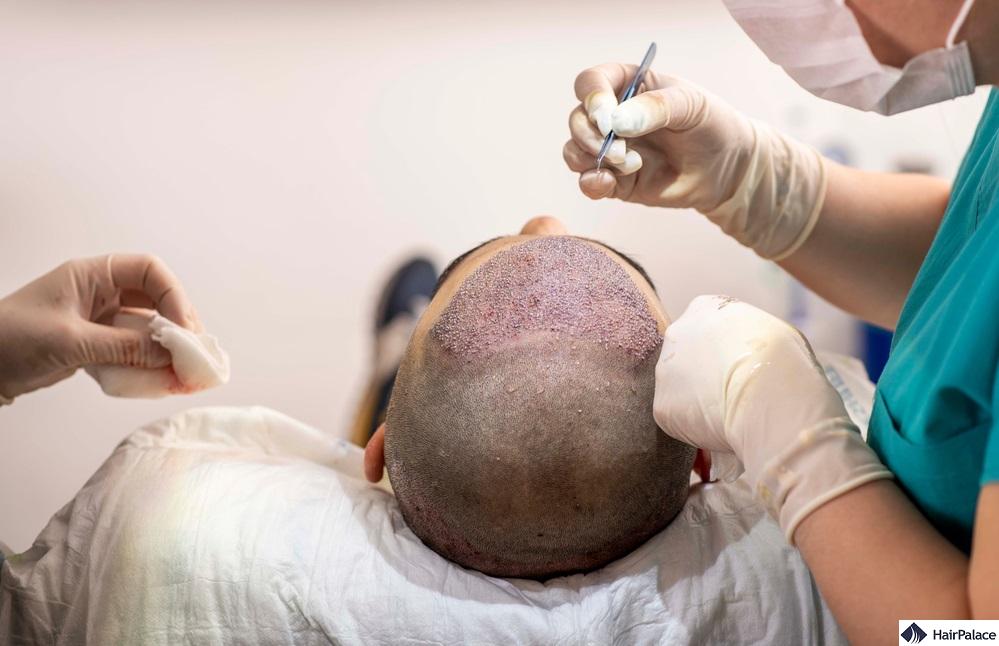Retrograde Alopecia: Causes, Symptoms and Treatment in 2025

Retrograde alopecia is the lesser-known cause of thinning hair, which remains a perplexing condition for many experiencing unexplained hair loss.
Unlike male pattern hair loss, the regions affected by retrograde alopecia include the nape of the neck, above the ears, and in some cases it can also extend to the sides of the scalp.
Treatment options include medications like minoxidil and finasteride, as well as lifestyle changes and hair transplantation.
This article will explore the latest findings, and offer an expert opinion on the nature and treatment of retrograde alopecia.
Let’s find out more about this complex disease.
What is Retrograde Alopecia?
Retrograde alopecia is where thinning occurs in the areas that are typically resistant to androgenetic alopecia.
These include the nape of the neck and the area above the ears.
Unlike common male pattern baldness, retrograde alopecia primarily affects these more uncommon areas leading to eventual follicular death.
The exact cause is not fully understood.
Scientists believe it’s related to hormonal factors similar to those involved in androgenetic alopecia.

What are the symptoms of retrograde alopecia?
The symptoms of retrograde alopecia include:
- Thinning of hair or hair loss in the areas typically resistant to common balding patterns. Specifically around the nape of the neck, above the ears, and sometimes the sides of the scalp.
- The hairline itself may remain intact, while the area of the scalp affected suffers from vertical alopecia.
- Individuals may experience weakened hair follicles and subsequent hair thinning in the frontal hairline similar to androgenetic alopecia. The difference is the atypical nature of the pattern of hair loss in these areas.
- Retrograde alopecia often comes with gradual thinning which can make it difficult to notice in the early stages.
To properly diagnose vertical thinning it’s best to seek advice from a dermatologist or hair restoration specialist who can advise on both surgical hair restoration options and non-surgical treatments.
How to measure retrograde alopecia?

Measuring retrograde alopecia involves a combination of clinical evaluation and diagnostic tools.
Here are the common methods used to evaluate and measure retrograde alopecia:
- Clinical Examination: A dermatologist or trichologist will perform a detailed scalp examination to identify the pattern of hair loss.
- Photographic Documentation: Taking standardized, consistent photographs of the affected areas over time can help in assessing the progression of hair loss.
- Dermoscopy: A handheld device called a dermatoscope can be used to magnify the scalp and hair follicles. This helps to identify subtle thinning and healthy hair count in the traditional donor area.
- Hair Pull Test: This involves gently pulling on a small section of hair to see how many hairs are easily removed.
- Trichoscopy: A form of dermoscopy specialized for hair and scalp conditions. It can be useful to assess lower-density hair closer and get a better idea about the state of finer hairs.
- Biopsy: A small scalp biopsy from the affected area may be taken and examined under a microscope to assess the hair follicles’ structure and any signs of scarring or inflammation.
- Hair Density Measurements: Tools and software can measure hair density and the percentage of miniaturized hairs in specific scalp regions, providing a quantitative assessment of hair loss.
Is retrograde alopecia reversible?
Retrograde alopecia, like other forms of hair loss linked to genetic factors (such as androgenetic alopecia), is generally considered to be a progressive condition that is not fully reversible.
Appropriate treatment can slow and even prevent the progression of hair loss in some cases.
Retrograde alopecia treatment
Treatment for retrograde alopecia focuses on managing the symptoms and attempting to slow the progression of hair loss.
Since retrograde alopecia shares characteristics with androgenetic alopecia, treatments often overlap.
Here are some common approaches to treating retrograde alopecia:
- Minoxidil: This topical treatment is applied directly to the scalp and can lead to higher-density hair by increasing blood flow to the hair follicles.
- Finasteride: An oral medication that reduces the production of dihydrotestosterone (DHT), a hormone implicated in hair loss.
- Dutasteride:Similar to finasteride, dutasteride is another medication that inhibits the production of DHT.
- PRP: The growth factors in PRP can stimulate hair follicle activity and promote new hair growth in patients with hair loss.
- Laser therapy: Certain devices can stimulate cellular activity in hair follicles by emitting specific wavelengths and thus improving hair growth.
- Hair Transplant Surgery: In cases where medical treatments do not yield the desired results, hair transplant surgery may be considered.
- Scalp Micropigmentation (SMP): For individuals looking for a cosmetic solution rather than hair regrowth, SMP involves tattooing the scalp with tiny dots that resemble the appearance of hair follicles.
- Lifestyle Changes and Supplements: While there are no direct treatments for retrograde alopecia, maintaining a healthy diet, managing stress, and getting enough vitamins and minerals can support scalp and hair health.
Is a retrograde alopecia hair transplant possible?

Hair transplantation can be an option for those suffering from retrograde alopecia but the treatment’s effectiveness and long-term results depend on certain factors.
The success of a hair transplant largely depends on the availability of healthy donor hair follicles.
It affects the nape of the neck, which usually prevents patients from being eligible for a hair transplant.
This condition often prevents patients from undergoing a hair transplant due to the characteristics of this condition.
Lastly, if the hair loss is ongoing, it might affect the results of the transplant, as newly transplanted areas could become surrounded by areas of thinning hair over time.
Retrograde Alopecia FAQ
Yes, it can progressively worsen over time without treatment.
Last medically reviewed on January 2nd, 2025
- ISHRS Practice Census 2022
- W.P. Unger, and R. Shapiro, eds. Hair Transplantation, 4th Edition. Marcel Dekker Inc.: New York; 2004.
- Hamilton, J.B. Patterned loss of hair in man: types and incidence. Ann NY Acad Sci. 1951; 53:708-728.
- Kim, J.Y., et al. Characteristics of nonbalding scalp zones of androgenetic alopecia in East Asians. Clin Exp Dermatol. 2015; 40(3):279-285.


